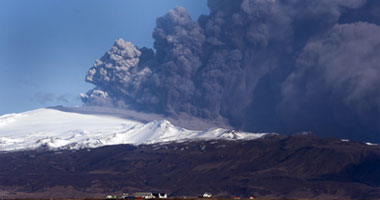 As volcanoes go, the eruption of Iceland's Eyjafjallajokull on April 13, won't make the science books. Though scientists haven't yet been able to gather enough information on the eruption to give it a score on the Volcanic Explosivity Index — which ranks volcanic events on a 1-to-8 scale — it's unlikely to score very high. Eyjafjallajokull barely compares to major eruptions like Mount St. Helens in 1980, which released 1.5 million metric tons of sulfur dioxide into the atmosphere, or the catastrophe of Krakatoa in Indonesia in 1883, which killed more than 40,000 people and was felt around the world. During Eyjafjallajokull, by contrast, there have been no deaths, and just 800 people living near the volcano had to be evacuated.
As volcanoes go, the eruption of Iceland's Eyjafjallajokull on April 13, won't make the science books. Though scientists haven't yet been able to gather enough information on the eruption to give it a score on the Volcanic Explosivity Index — which ranks volcanic events on a 1-to-8 scale — it's unlikely to score very high. Eyjafjallajokull barely compares to major eruptions like Mount St. Helens in 1980, which released 1.5 million metric tons of sulfur dioxide into the atmosphere, or the catastrophe of Krakatoa in Indonesia in 1883, which killed more than 40,000 people and was felt around the world. During Eyjafjallajokull, by contrast, there have been no deaths, and just 800 people living near the volcano had to be evacuated.But Eyjafjallajokull's eruption has still had a major impact on the world, as its 7-mile-high plume of volcanic gases and silicate ash has spread across much of Europe, bringing air travel across the continent to a near standstill. Delays and cancellations hit airports from Toronto to Tokyo, and the problems have cost the global air-travel industry an estimated $200 million a day. Not bad for a distinctly minor-league eruption.
Still, the havoc caused by Eyjafjallajokull is a reminder that in our globalized, interconnected world, it's less the sheer power of a natural disaster than where and when it happens — and how prepared we are to respond. Eyjafjallajokull was at the right place at the right time to wreak maximum havoc on air travel. (Even relatively small amounts of volcanic ash high in the air can clog sensitive jet engines, shutting down ventilation and causing the machinery to melt down and fail.) If the volcano had erupted in the years before air travel became common, it wouldn't have caused trouble for anyone but the people of Iceland.
The same goes for other kinds of natural disasters. The earthquake that hit Haiti in January killed some 230,000 people, yet the temblor registered only a 7.0 on the Richter scale — bad, but not that bad. In fact, the quake barely compared to the 8.8 temblor that hit Chile a little more than a month later, killing fewer than 500 people. What's the difference? Population density — the Haiti quake struck the country's dense capital of Port-au-Prince, while the Chile one missed big cities like Santiago — and preparation. Chile is a relatively well-off South American nation with a long history of earthquakes, so its buildings are designed to resist seismic waves, and the government and people know how to respond to a disaster. Impoverished Haiti, by contrast, was helpless, and its people paid the price.
As global populations have grown and people have crowded into risk zones — like earthquake areas and flood plains — the toll of natural disasters has grown as well. According to the Center for Research on Epidemiology of Disasters, the number of catastrophic events has more than doubled since the 1980s, and the Red Cross estimates that the economic damage from disasters rose fivefold, to $629 billion, from 1985 to 2005. That doesn't necessarily mean that volcanoes and quakes are getting worse — but rather that there are more of us living in areas where we might be affected by a disaster, and we have more to lose.
Fortunately, global wealth and technology allow us to better prepare for and respond to natural disasters. In the case of the Eyjafjallajokull eruption, European air-traffic controllers already had plans in place to deal with ash clouds. Shutting down the continent's airspace and grounding thousands of flights was expensive and inconvenient, but it was far preferable to having planes fall out of the sky. And while the economic toll of such disasters may be rising, huge death tolls are far less common. In 1783, the volcano Laki in Iceland erupted on a massive scale, throwing so much ash and sulfur dioxide into the atmosphere that it led to a famine that killed half of Iceland's livestock and 25% of its population. An eruption of that size today likely wouldn't cause nearly as dramatic a death toll — though it might well interrupt flyers for weeks or even months.
Authorities hope Eyjafjallajokull will quiet down in the days to come and the ash cloud will disperse, allowing European air travel to return to normal — although its last eruption, in 1821, went on for two years. Yet the volcano's worldwide impact should not have come as a surprise, considering the fallout from Iceland's economic collapse in 2008, which affected borrowers across Europe. In natural disasters as well as the financial system, what happens in Iceland doesn't always stay in Iceland.
_______________________
TIME magazine (abridged)



